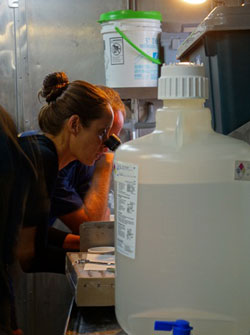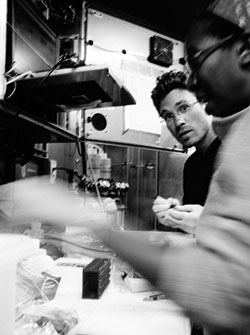2012 Maritime Heritage Expedition Log by Etta Karth – July 19, 2012
Surveying for Marine Alien Species
The Marine Alien Species Team is conducting surveys for marine alien species within the Monument, inventorying non-native invertebrates at each of the stops. The purpose of their work is to better understand the distribution of established alien species and determine if there are any new alien inverts in PMNM.
Team: Scott Godwin (PMNM Resource Protection Specialist, Alien Invasive Studies), Holly Bolick (Bishop Museum, Hawaii Biological Survey Collections Manager).

Holly Bolick views and documents collected samples in the wet lab to see if she can identify any new alien invasive species within PMNM. Credit: Etta Karth/NOAA

Johnathan Whitney works with Sherill Leon Soon in the ship's wet lab processing and documenting coral samples to track and identify coral diseases throughout PMNM. Credit: Etta Karth/NOAA
Studying Coral Disease
The Coral Disease team is conducting surveys of diseased corals and studying the genetics of coral diseases. They dive with a variety of gear (hammers, clippers, vials, baggies) to collect and store coral samples. They are looking for anomalies in previously sampled permanent transect sites within PMNM to monitor changes in diseased coral.
Team: Stephen Karl (HIMB PhD lead scientist), Johnathan Whitney (HIMB Masters student), Sherril Leon Soon (HIMB Masters student), Jackie Troller (HIMB Masters student).
